SOWK 486 - Week 07 - Counterproductive Communication
A presentation at Heritage University @ CBC Week 07 in in Pasco, WA 99301, USA by Jacob Campbell
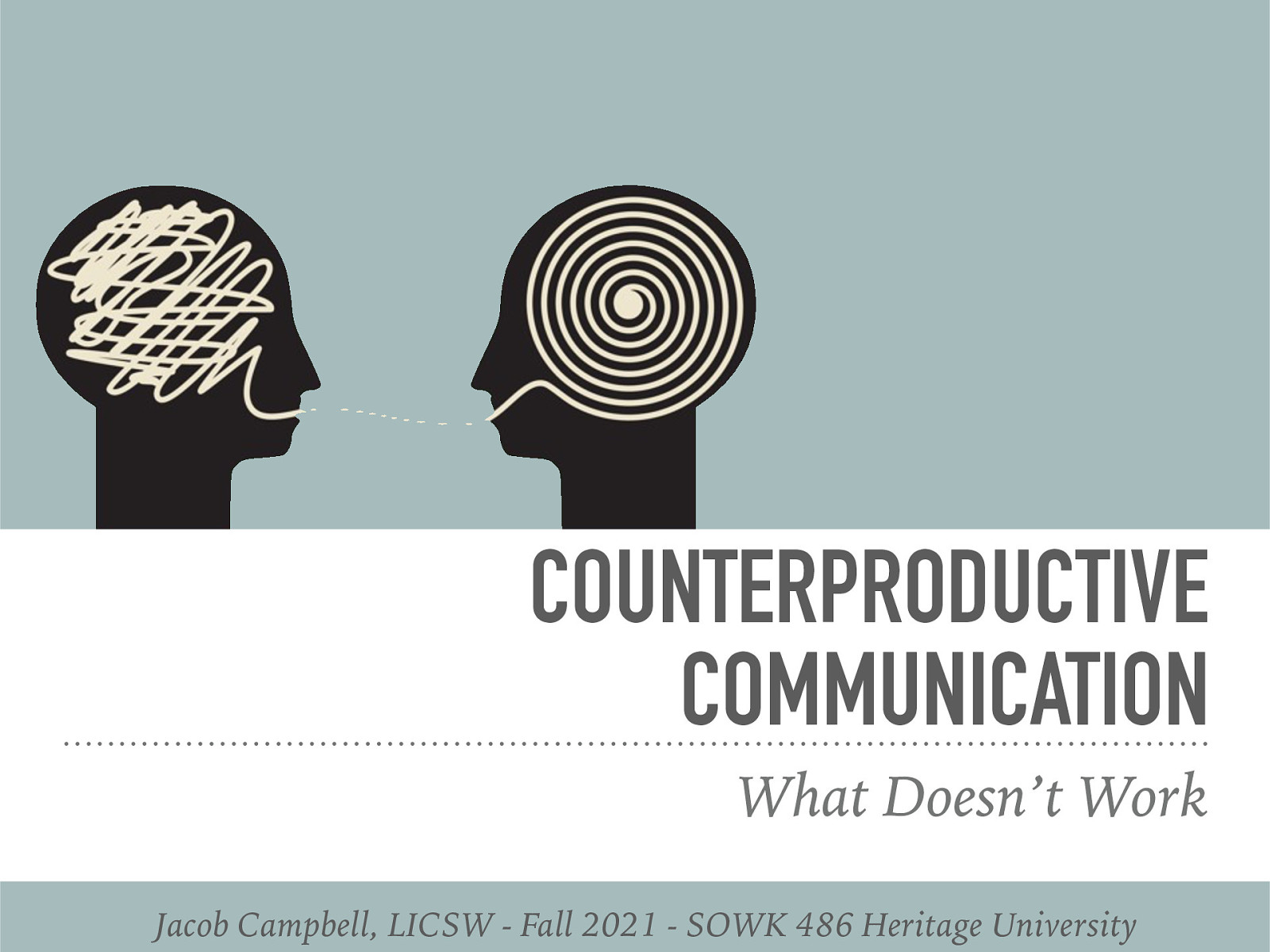
SOWK 486 Fall 2021 Planning: Class 07
SOWK 486 Fall 2021 Planning: Class 07
Week 07: 10/06/21 Content: Counterproductive Communication Reading: Hepworth et al. (2017) chapter seven Due:
- A-02: Reading Quiz for chapter seven is due at 5:30 PM before class via My Heritage
- A-03: Theory and Practice Integrative Paper due Friday 10/08/21 at 11:55 PM via My Heritage
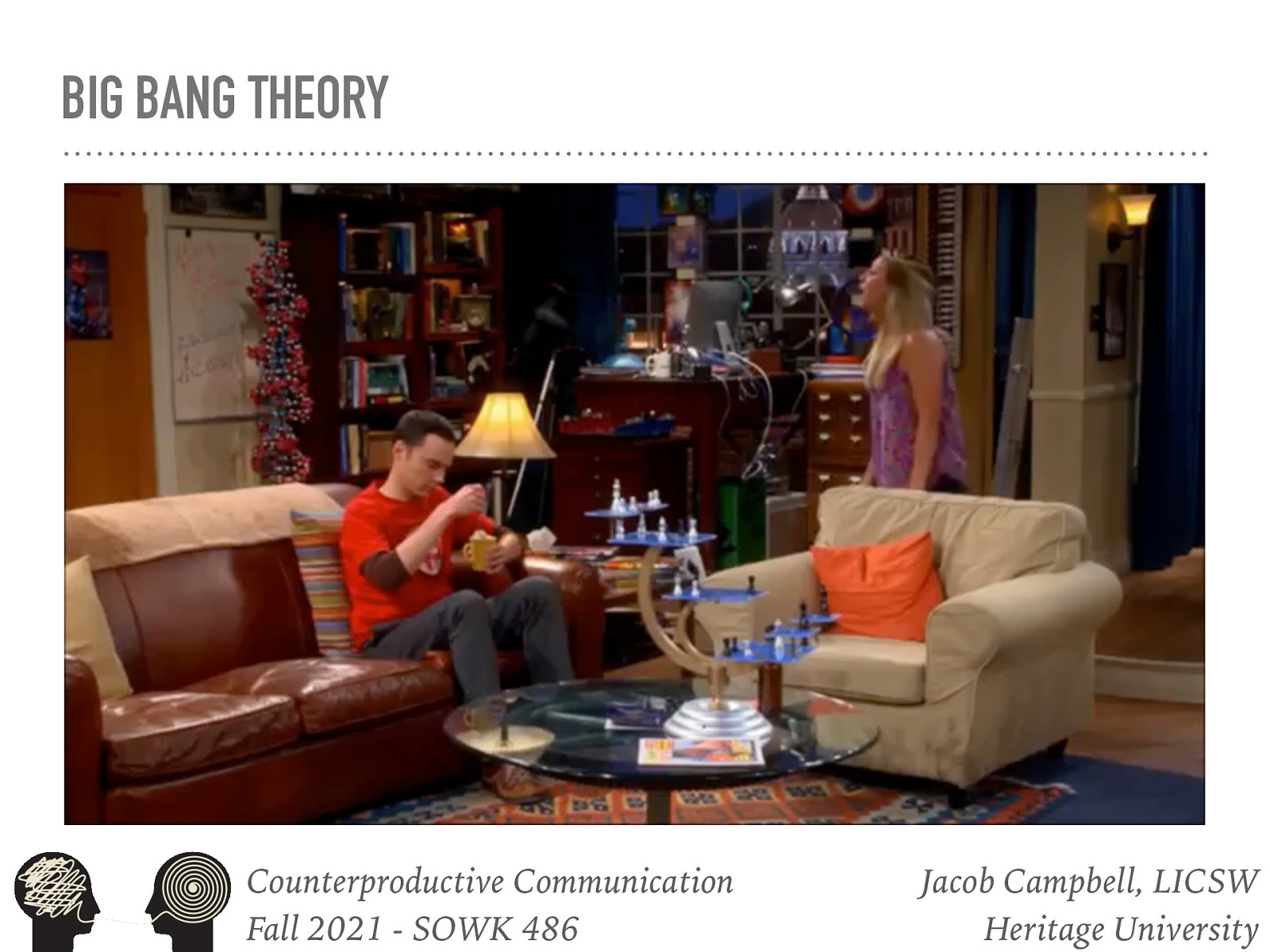
Big Bang Theory Video Clip
[Whole Class Activity] Watch the video clip.
Sheldon uses some counterproductive communication patterns. While, with the relationship that Sheldon has with Penny, he seems to be effective. Today we are spending time talking about some of the what not to do.
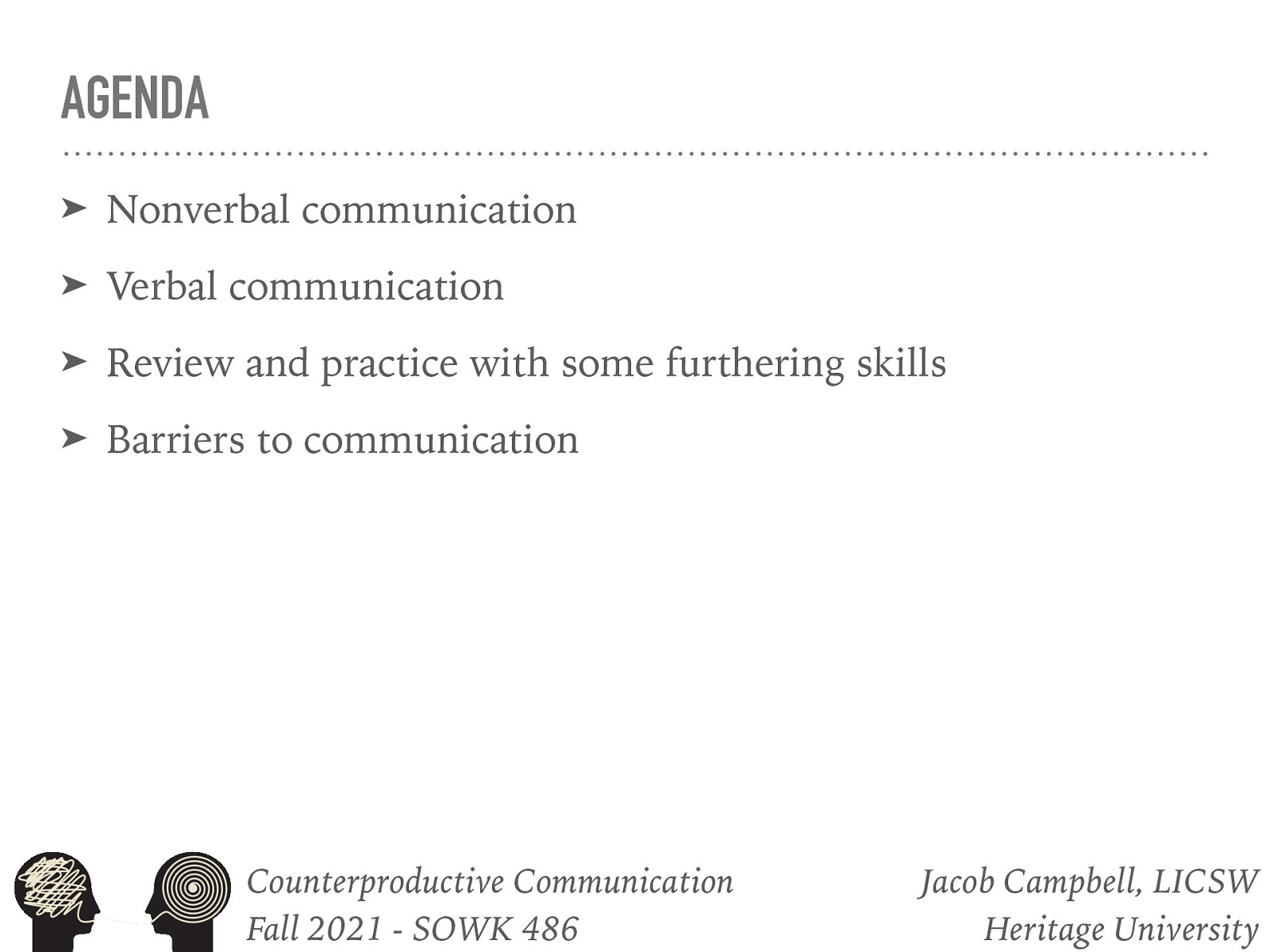
Agenda
- Nonverbal communication
- Verbal communication
- Review and practice with some furthering skills
- Barriers to communication
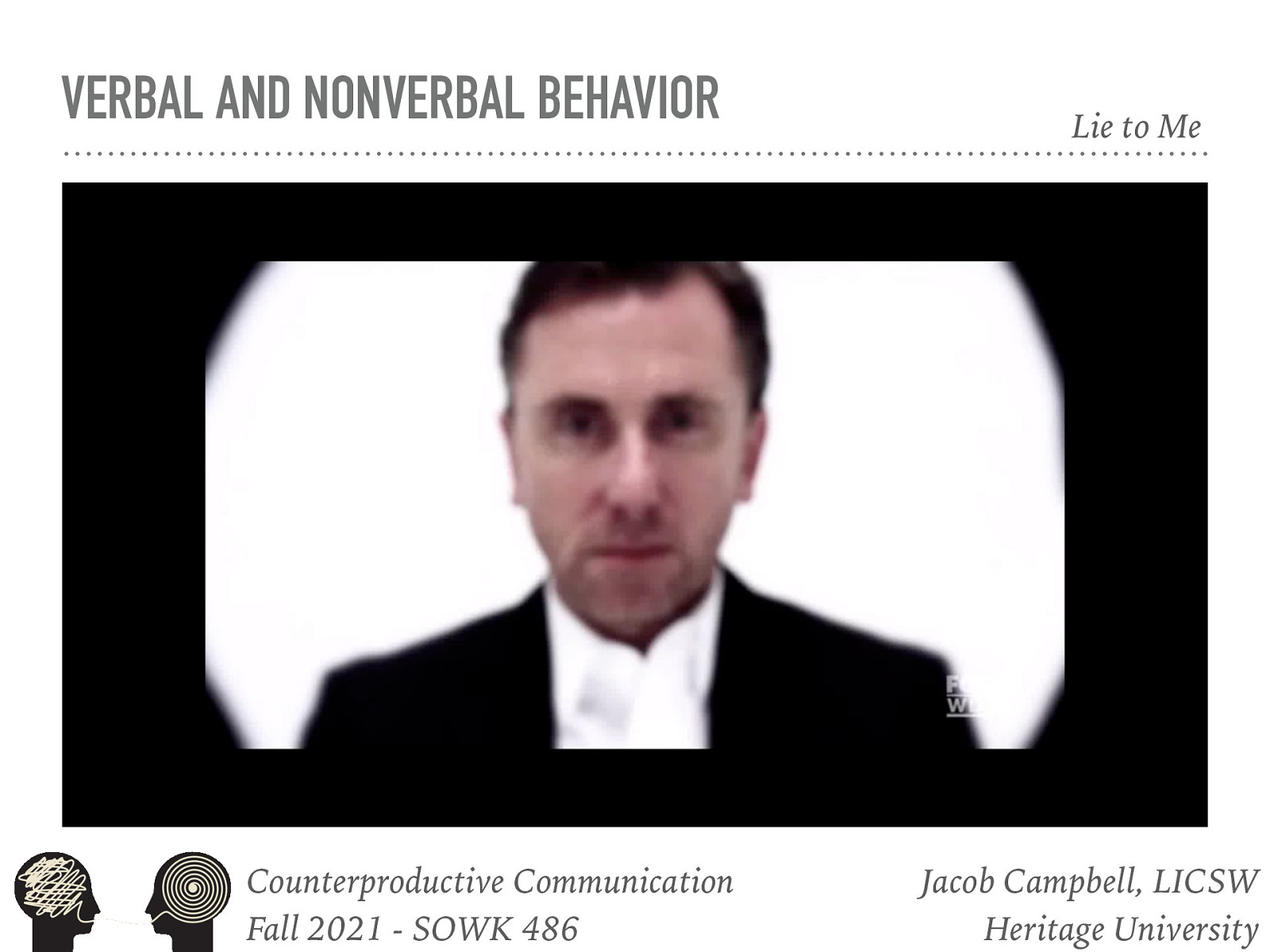
Verbal and Nonverbal Behavior
How we manage and deal with verbal and non verbal behavior has a lot to do with how we are able to communicate. > [Discussion] Who has seen Lie to Me?
[Activity] Watch Lie to Me Intro video
Lie to Me is not actually exactly accurate, but there is some truth.
- Human interaction and communication involve both verbal and nonverbal behavior.
- Verbal behavior is what is being said.
- Non verbal behavior is communication in ways other than spoken words.
- People communicate by…
- Facial expressions
- Hand movements
- Eye contact
- Sitting position
- Proximity
- Any aspect of a person’s presence that conveys ideas or information without being spoken is nonverbal communication.
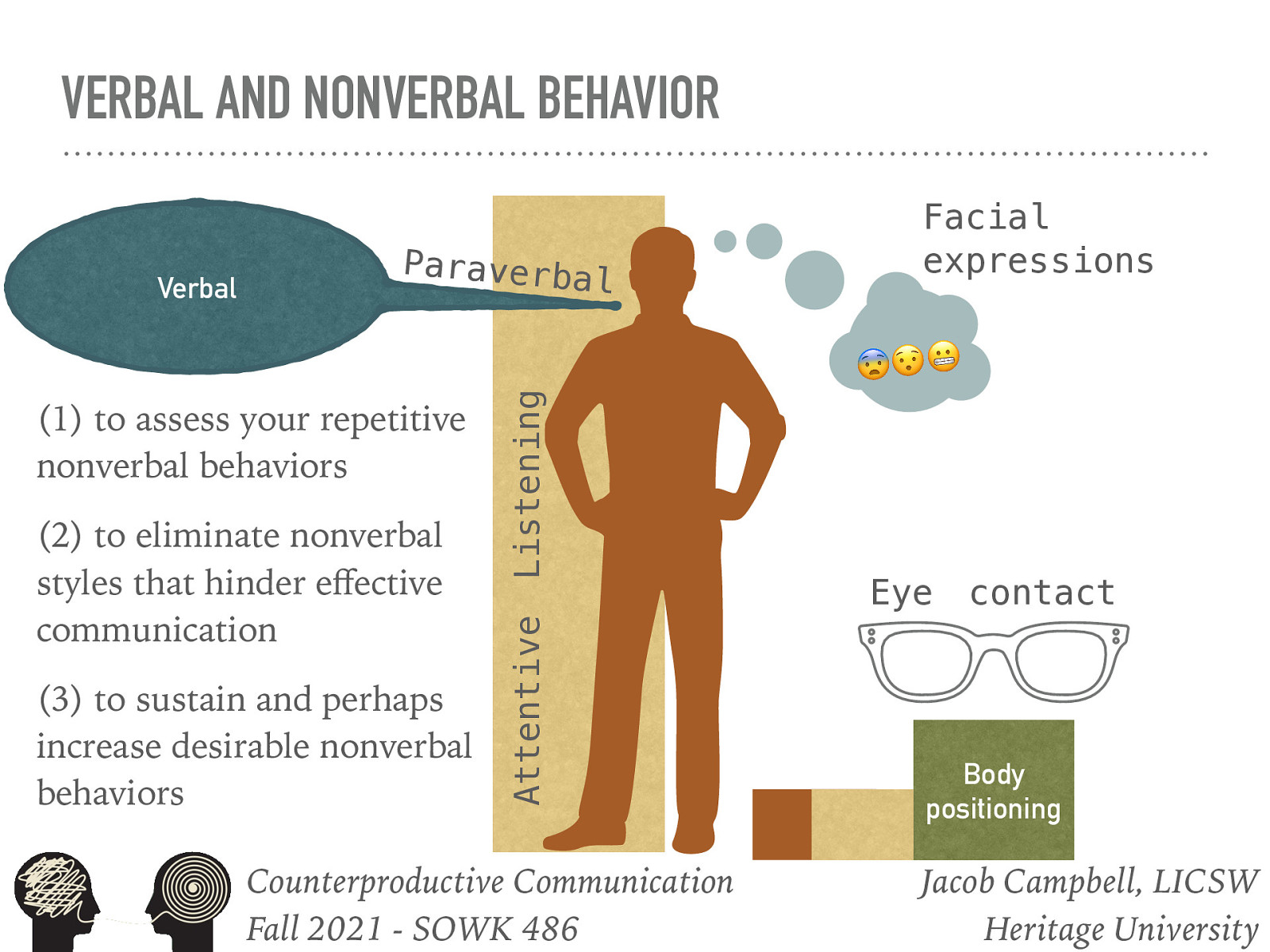
Verbal and Nonverbal Behavior
Any aspect of a person’s presence that conveys ideas or information without being spoken is nonverbal communication. In communication in general, there are six basic parts of communication:
- Attentive listening
- Eye contact
- Facial expressions
- Body positioning
- Paraverbal
- Verbal
As we think about these verbal and non verbal aspects, we should also be thinking about this threefold task:
(1) to assess your repetitive nonverbal behaviors (2) to eliminate nonverbal styles that hinder effective communication (3) to sustain and perhaps increase desirable nonverbal behaviors
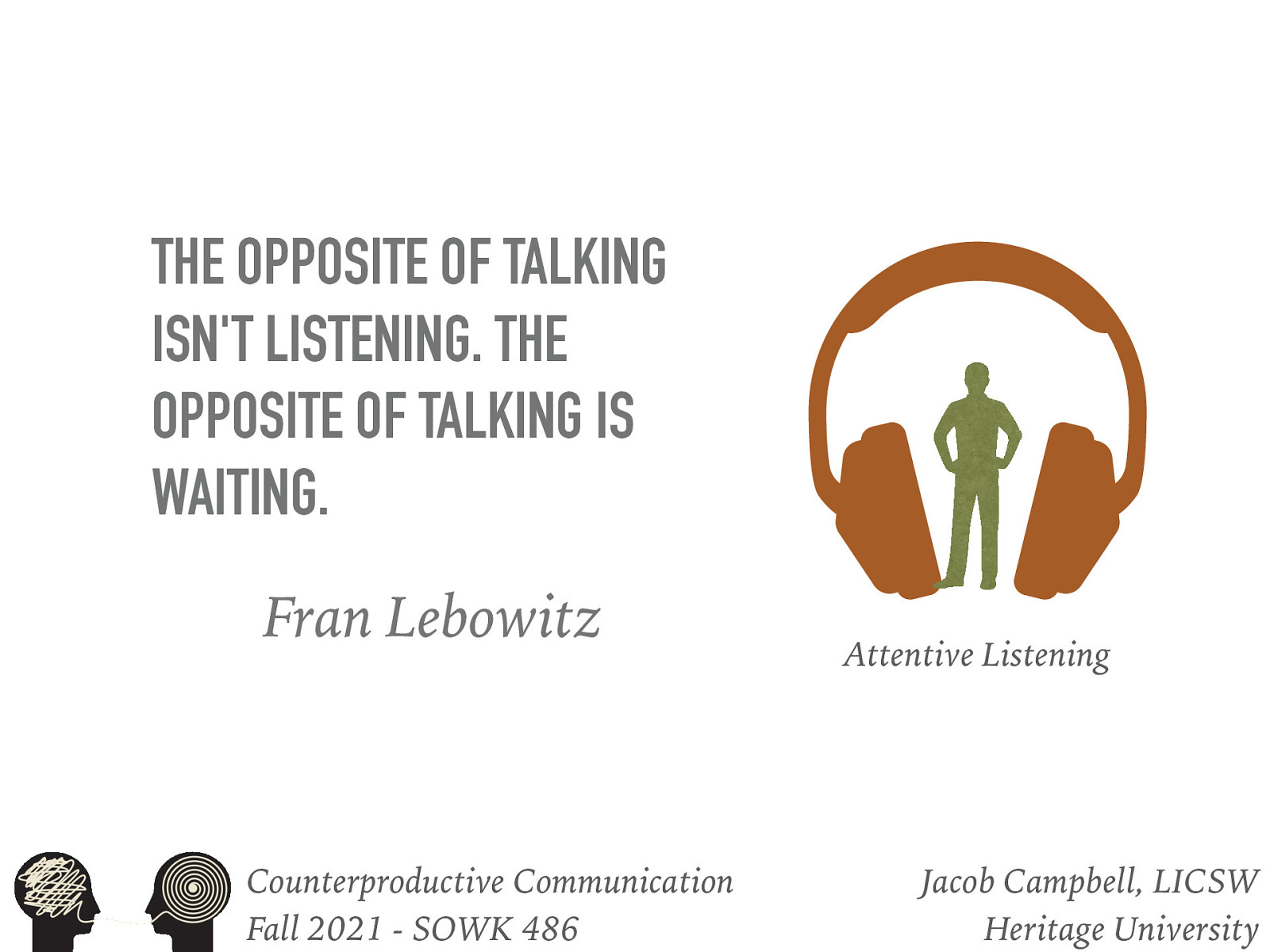
Attentive Listening
The opposite of talking isn’t listening. The opposite of talking is waiting. ~ Fran Lebowitz
Attentive listening implies more than just audio reception of the words that are said. It focuses on comprehending the meaning of what is said. This can be called physical attending.
It takes really focusing on the person that you are talking to.
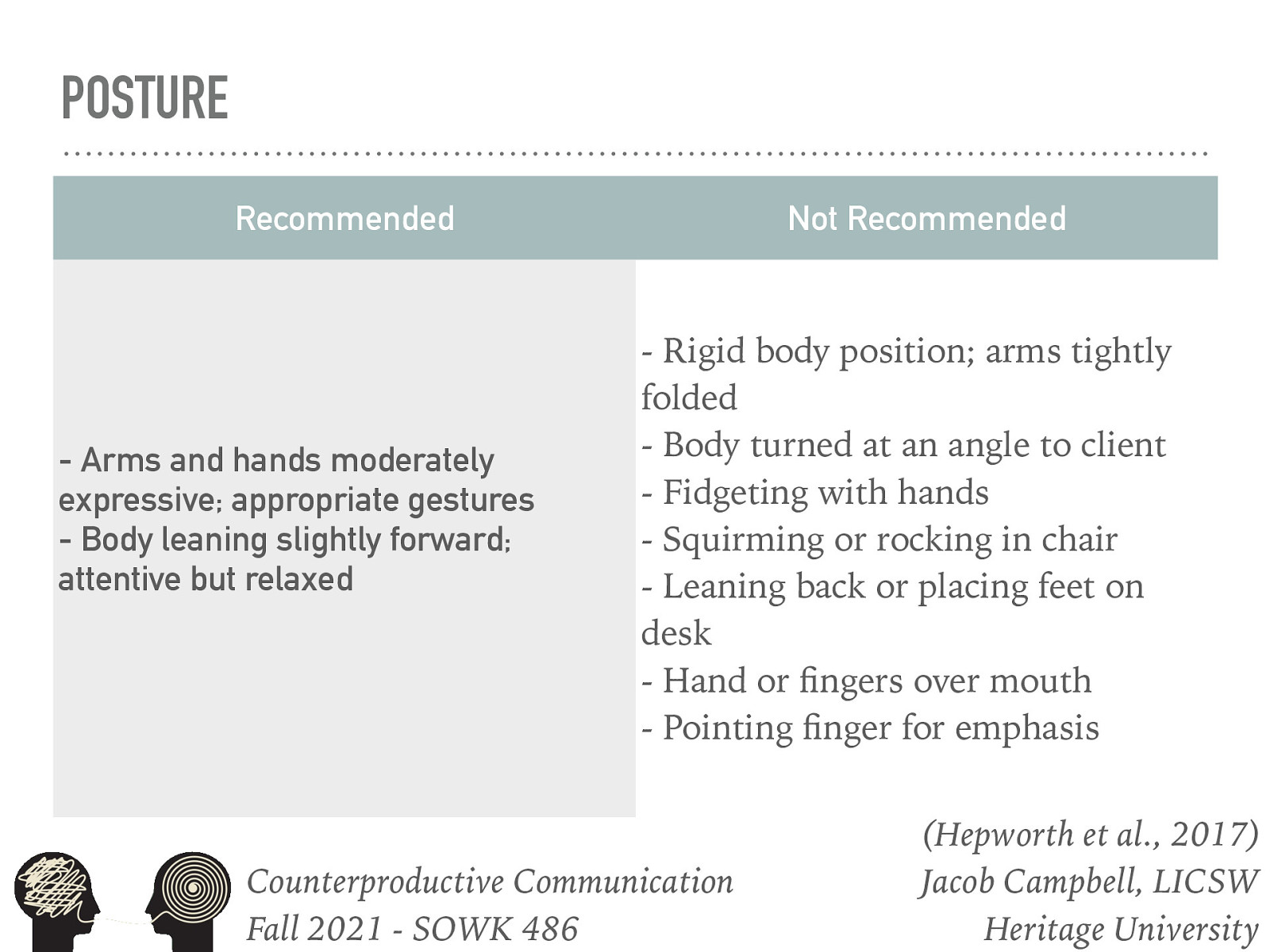
Posture
Recommended
- Arms and hands moderately expressive; appropriate gestures
- Body leaning slightly forward; attentive but relaxed
Not Recommended
- Rigid body position; arms tightly folded
- Body turned at an angle to client
- Fidgeting with hands
- Squirming or rocking in chair
- Leaning back or placing feet on desk
- Hand or fingers over mouth
- Pointing finger for emphasis
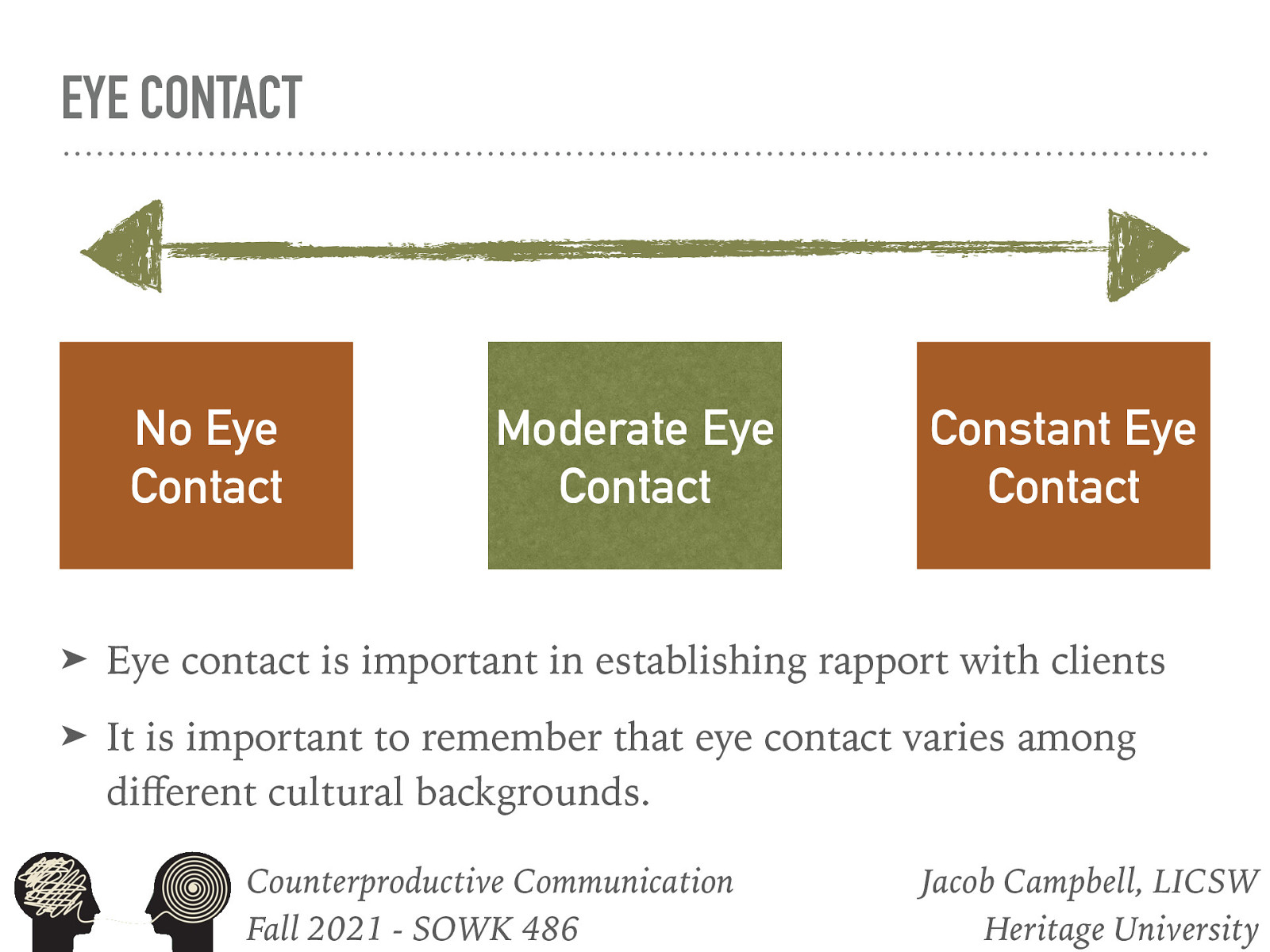
Eye contact
We don’t want to have no eye contact and we don’t want to have constant eye contact. We want to have moderate eye contact, which is somewhere in between no eye contact and constant eye contact.
Not extremes…
No Eye Contact
Constant Eye Contact
Moderate Eye Contact
Purpose
- Eye contact is important in establishing rapport with clients.
Variability
- It is important to remember that eye contact varies among different cultural backgrounds.
Significance
- The inability to make eye contact could mean that someone is afraid or insecure, it might also imply disinterest or dishonesty.
- On the other hand maintaining constant eye contact can be intimidating or make someone uncomfortable.
- Eye contact is a complex nonverbal behavior.
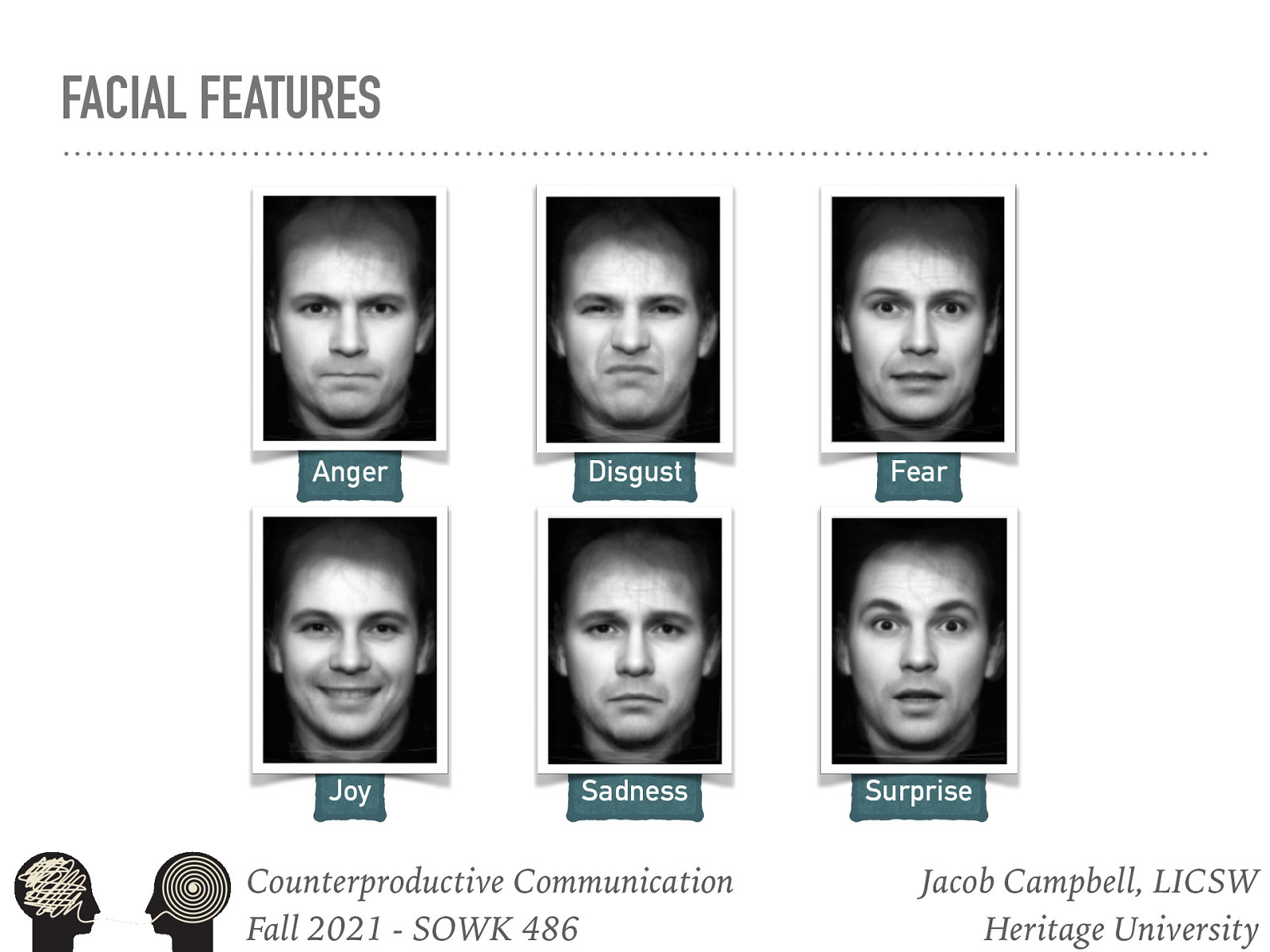
Facial Expressions
[Activity] What emotion are each of these facial features expressing?
- Like everything in SW, It’s about self evaluation
- Not only are are we looking at the facial features or affect of the client, but become aware of our own.
- Are our facial expressions corresponding with our other nonverbal behavior and what we are saying?
- Facial expressions provide an excellent means of communication.
- Facial expressions can be used to reinforce what is said verbally and emphasize the fact that you mean what you say.
- We need to be concerned about if we have incongruence and leakage (e.g. feelings about client leaked out)
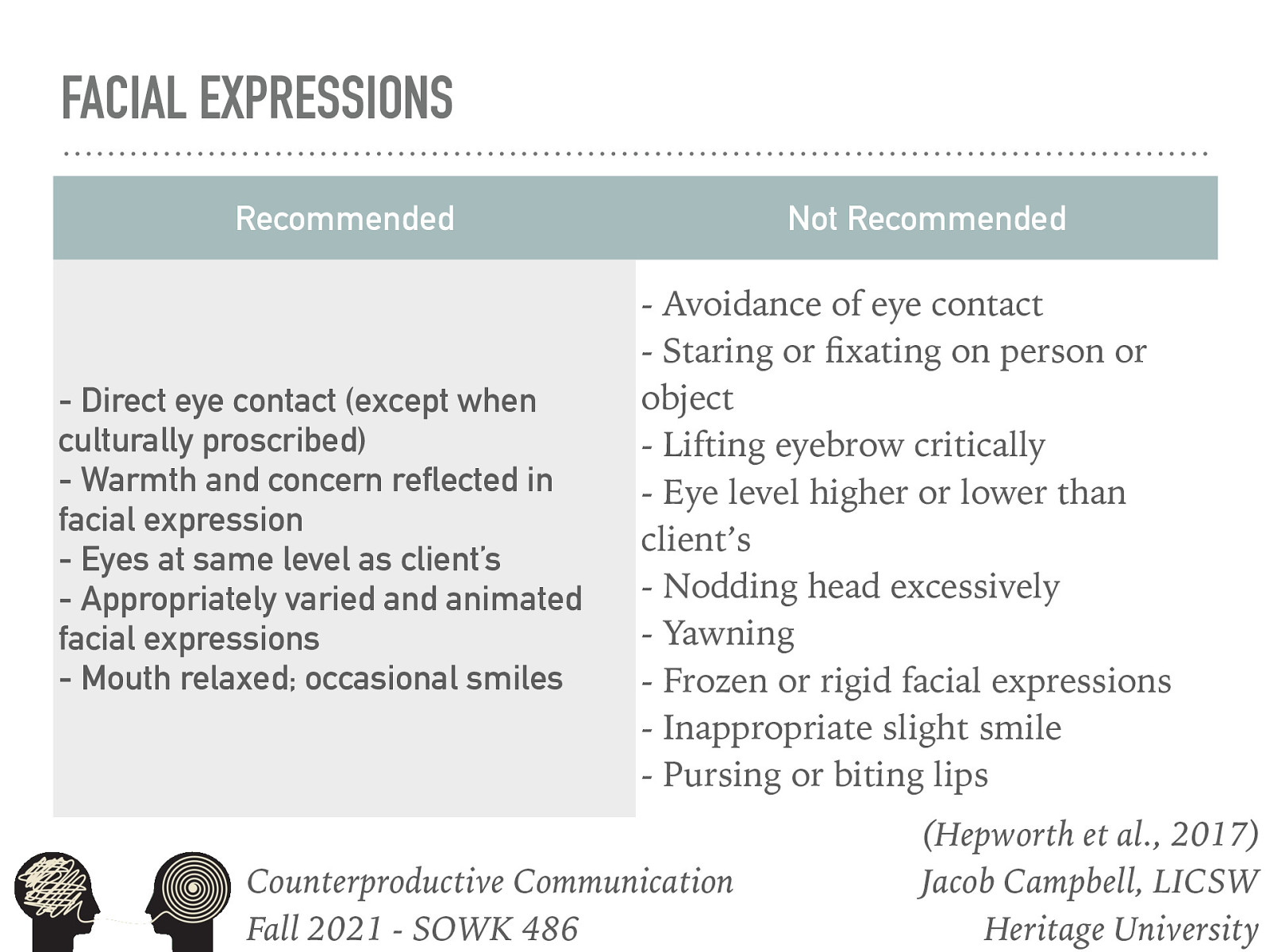
Facial Expressions
For both facial features and eye contact the following are the recommendations based in the Hepworth et al. (2017) text.
Recommended
- Direct eye contact (except when culturally proscribed)
- Warmth and concern reflected in facial expression
- Eyes at same level as client’s
- Appropriately varied and animated facial expressions
- Mouth relaxed; occasional smiles
Not Recommended
- Avoidance of eye contact
- Staring or fixating on person or object
- Lifting eyebrow critically
- Eye level higher or lower than client’s
- Nodding head excessively
- Yawning
- Frozen or rigid facial expressions
- Inappropriate slight smile
- Pursing or biting lips
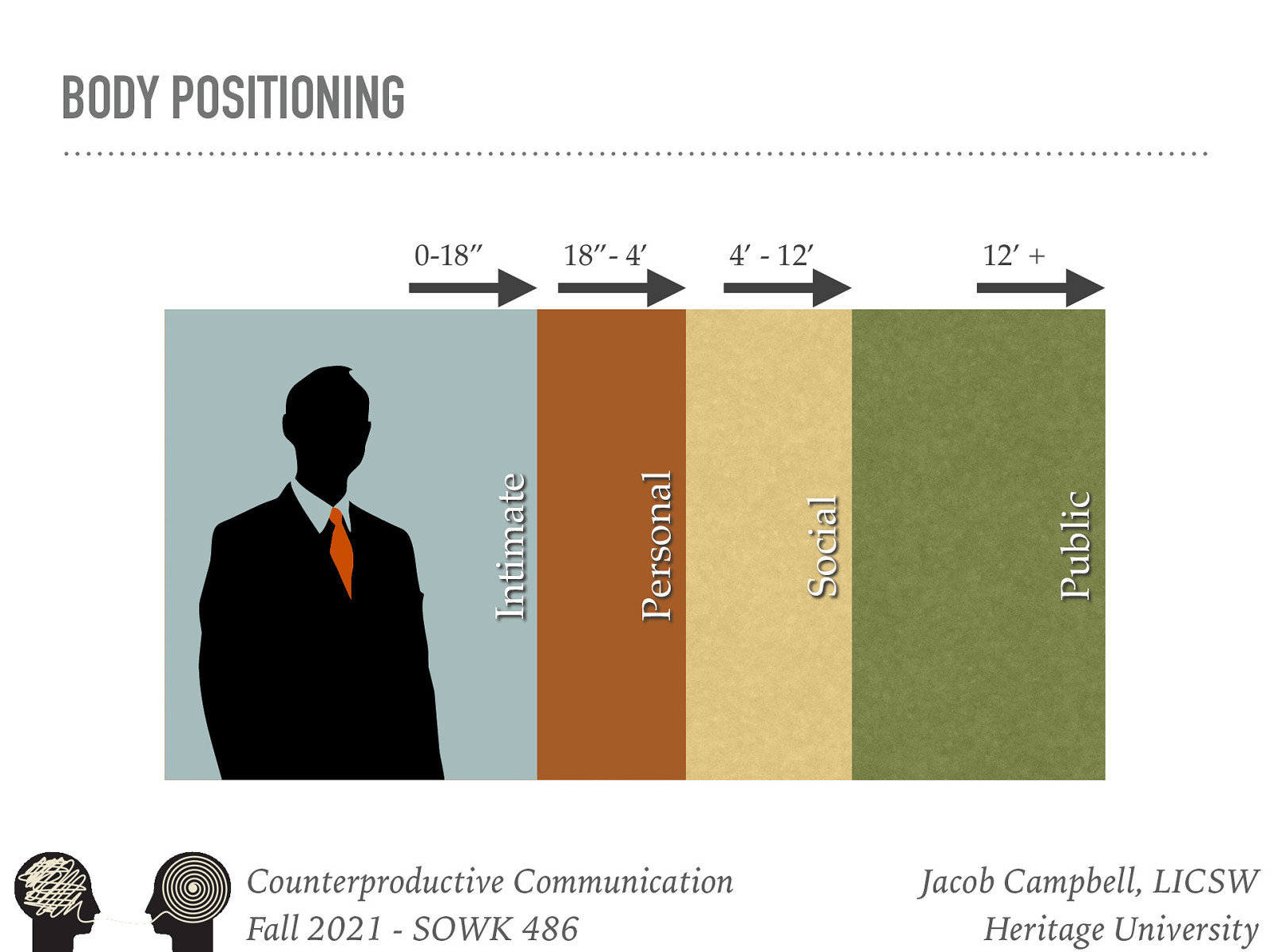
Body Positioning
[Activity] Class participant to demonstrate space. (Clinicians should be at the closer end of social)
- Distance
- The use of personal space or distance between you and the client is a part of body positioning.
- Psychomotor behavior (Body Positioning)
- Body movement and positioning also provide information to others.
- Being tense or relaxed. This is noted in your body position.
- Tension vs. Relaxed Positions
When working with clients it is important how you present yourself nonverbally.
[Activity] Have a student act out what it might look like to be tense vs. relaxed.
- Tension
- Extreme tension could convey lack of confidence or excessive nervousness.
- It could cause distance between you and the client and they may have a difficult time feeling comfortable or trusting you.
- Relaxed
- But on the other hand being too relaxed could give the impression that you do not care much about what happens
- It could damage your professional credibility.
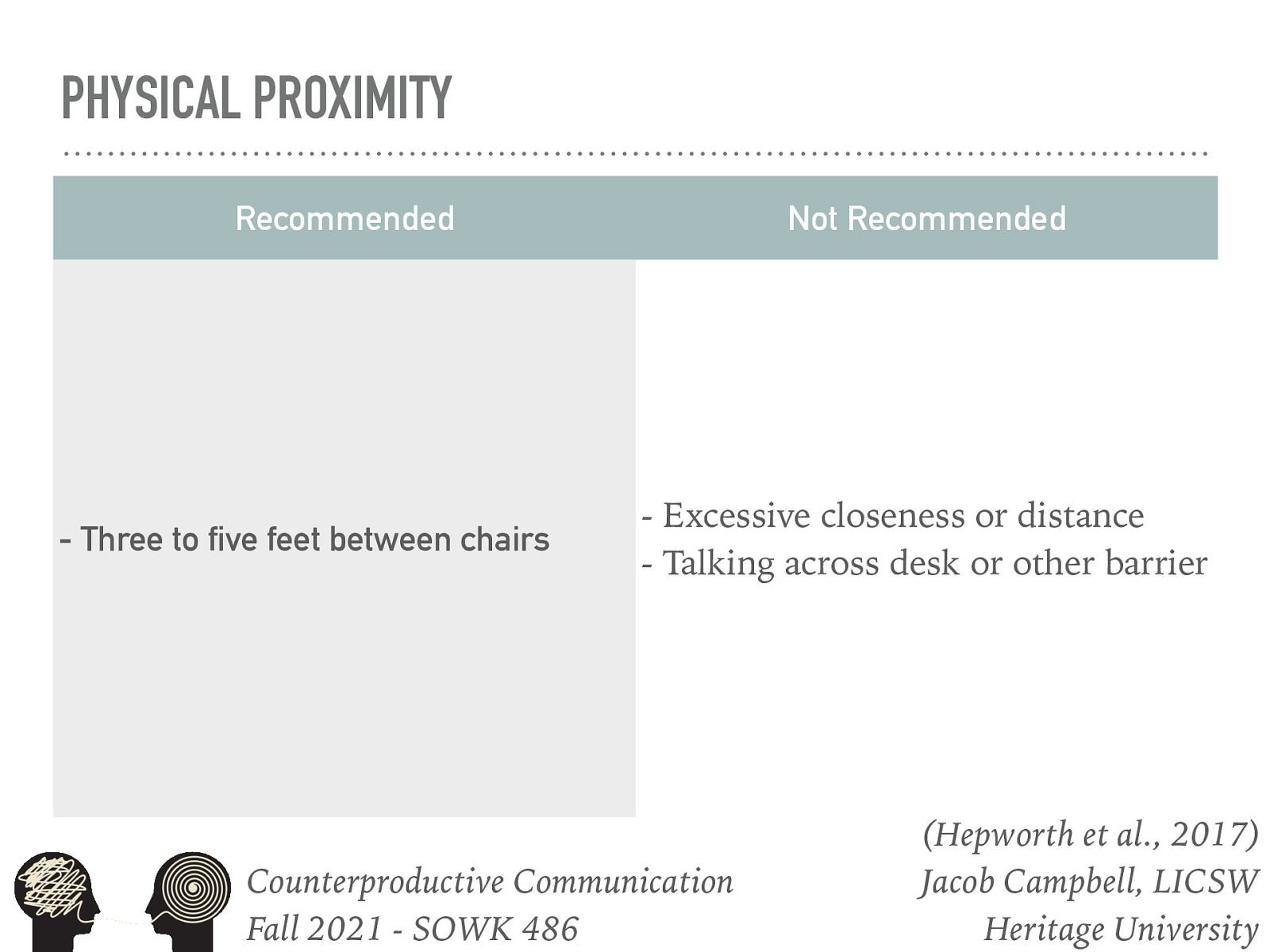
Physical Proximity
Recommended
- Three to five feet between chairs
Not recommended
- Excessive closeness or distance
- Talking across desk or other barrier
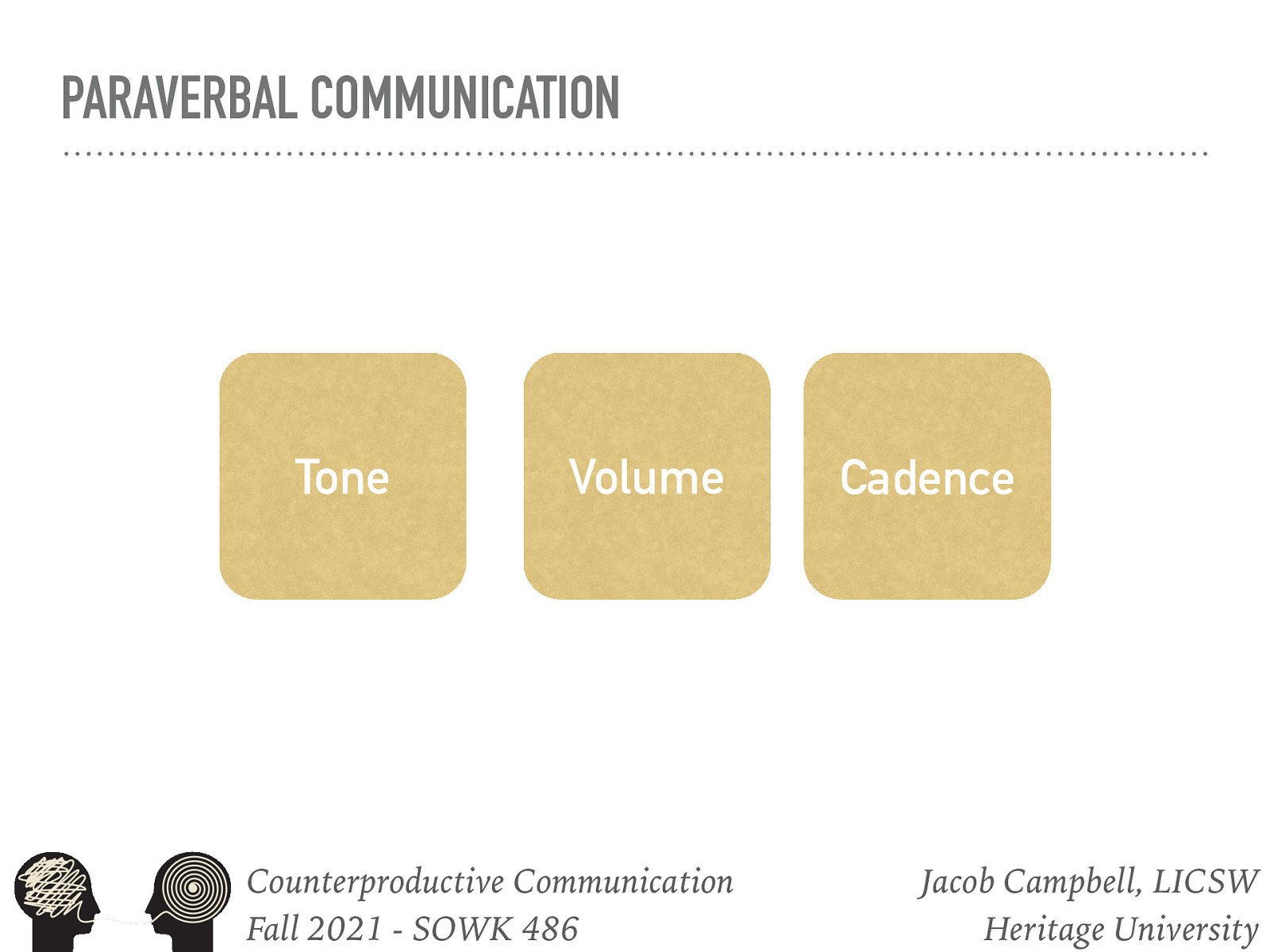
Paraverbal Communication
Paraverbal communication is the how we say the things we say, not the words we use.
[Discussion] What is each
[Whole Class Activity] “How can I help you?” Have class members repeat the phrase with varying emphasis.
- Tone
- Volume
- Cadence
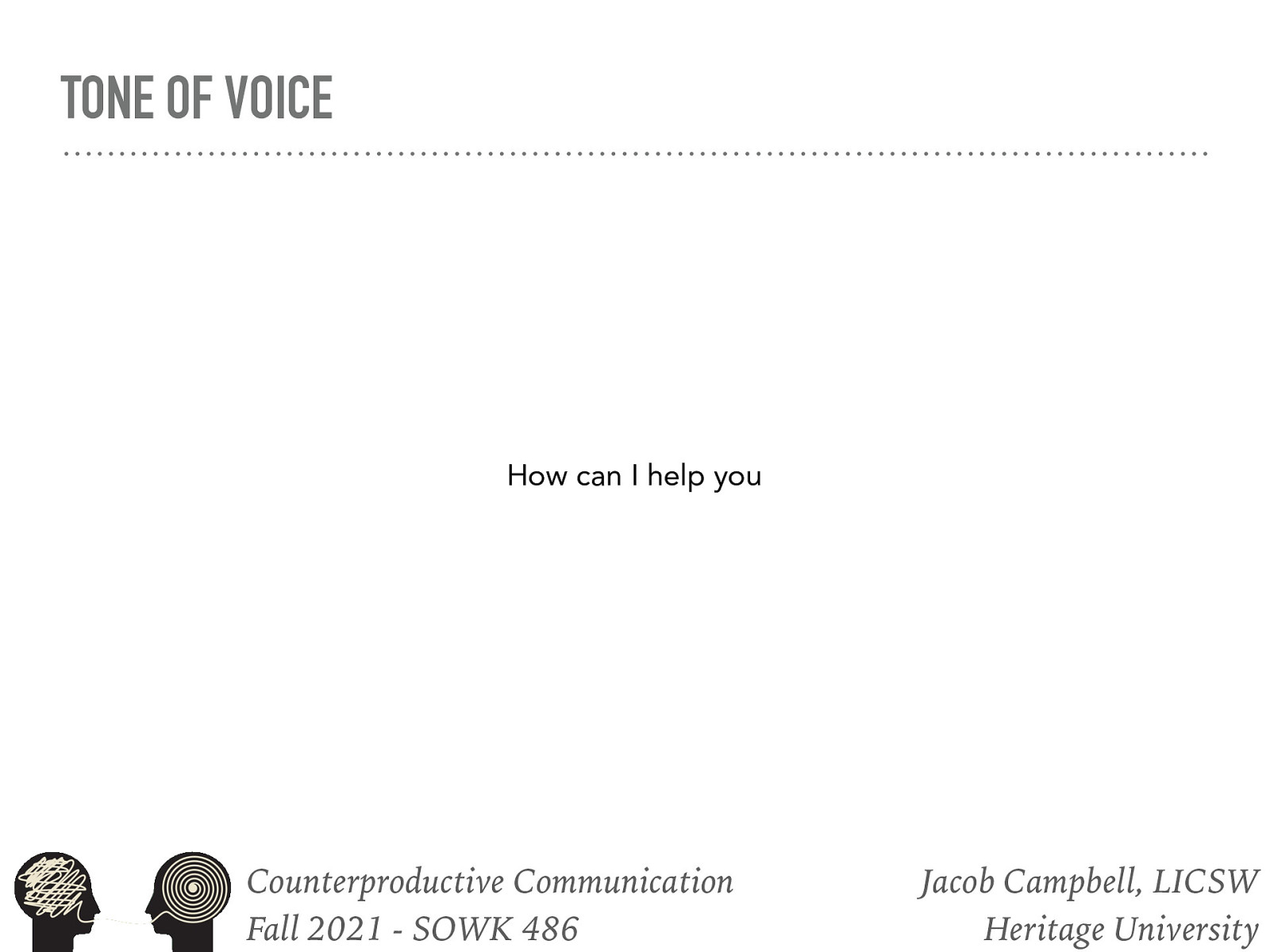
Tone of Voice
[Whole Class Activity] Have students go around and put emphasis on different words in the sentence “how can I help you.”
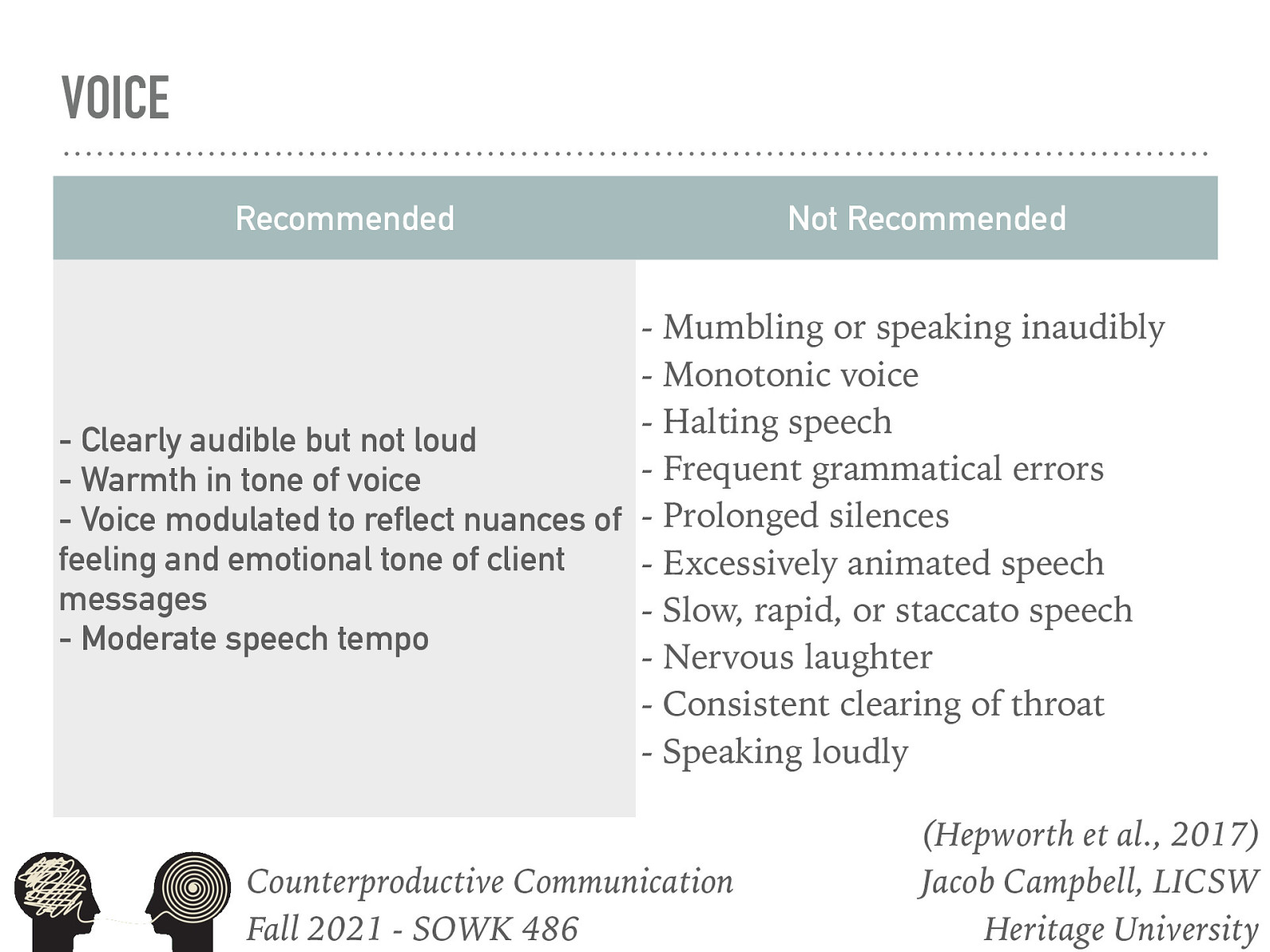
Voice
Recommended
- Clearly audible but not loud
- Warmth in tone of voice
- Voice modulated to reflect nuances of feeling and emotional tone of client messages
- Moderate speech tempo
Not Recommended
- Mumbling or speaking inaudibly
- Monotonic voice
- Halting speech
- Frequent grammatical errors
- Prolonged silences
- Excessively animated speech
- Slow, rapid, or staccato speech
- Nervous laughter
- Consistent clearing of throat
- Speaking loudly
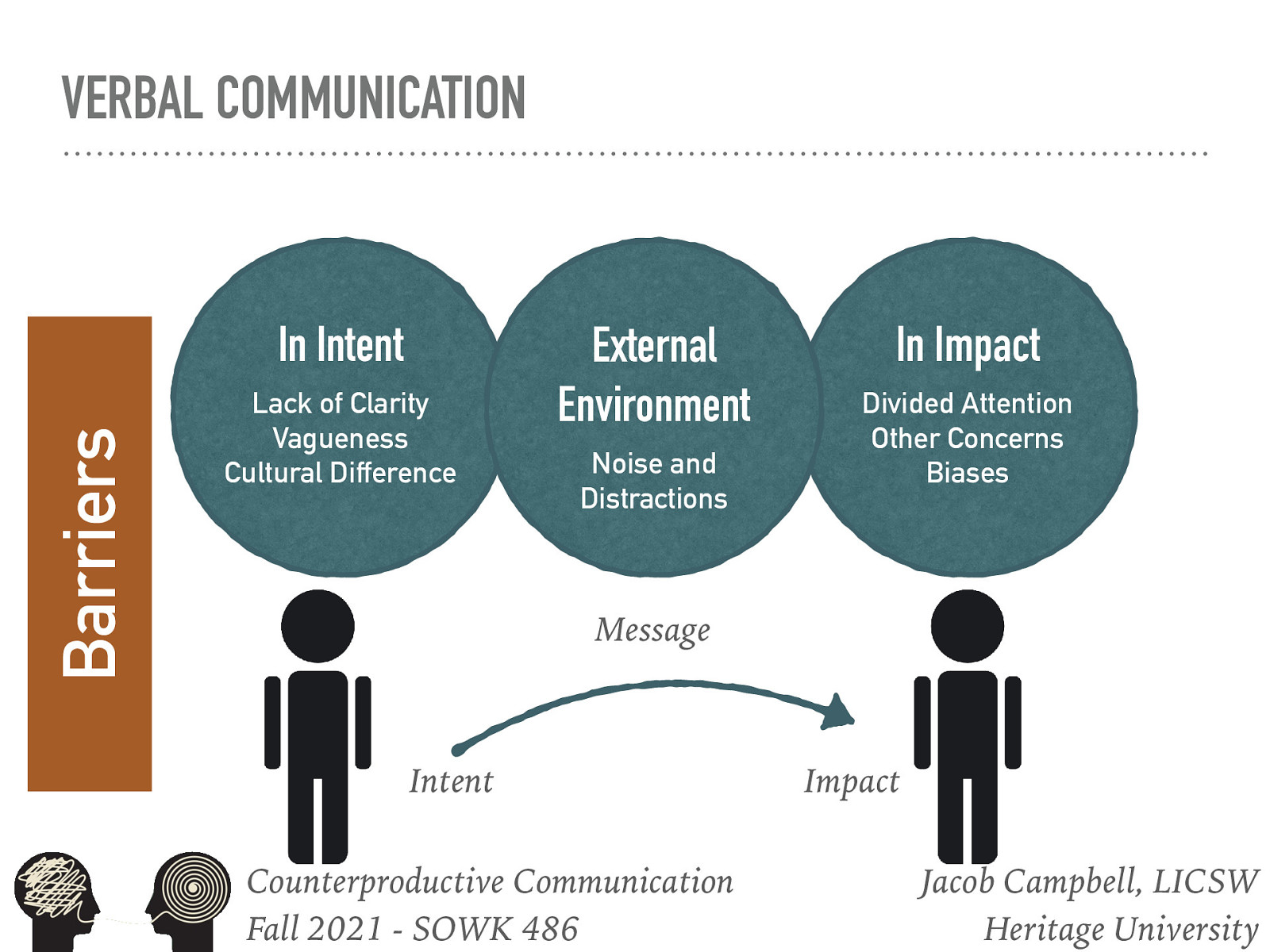
Verbal Communication
There can be barriers to verbal communication through the messages we try to send in our verbal communication.
Every time we communicate a message with another person or group of people, there is an intent and an impact. At both of these levels, there can be barriers.
Message
Barriers in …
Intent
Impact
In Intent
- The client may be using words, phrases, or concepts that are not clear to you.
- The client may be saying something vague, and their intent is not what you interpret.
In Environment
- Thinking what your going to say next
- Phones ringing
- Home visits
- Children
In Impact
- Concerns regarding crisis
- Personal problems
- Biases
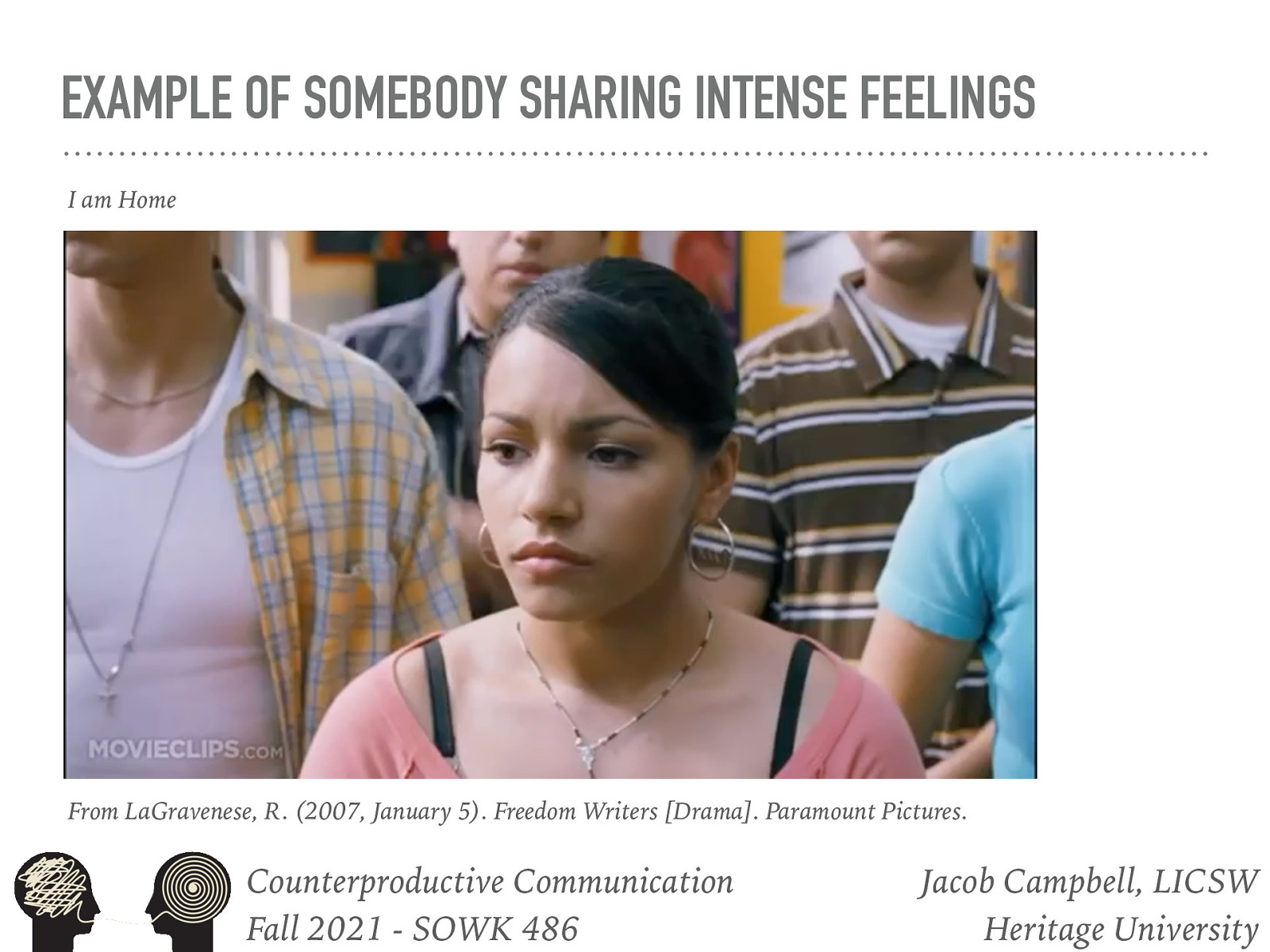
Example of somebody Sharing Intense Feelings
in the LaGravenese (2007) the Freedom Writers this character shares an intense story from his journal. We are going to watch this short video clip and then talk about reflective responding as an activity. I want to use this clip as a way of considering responding
[Whole Class Activity] Watch the video clip
We will often have clients that just share really difficult things such as this. Often there is no best response… and our best response might vary depending. It might be as simple as “thank you for sharing…”
Reference: LaGravenese, R. (2007, January 5). Freedom Writers [Drama]. Paramount Pictures.
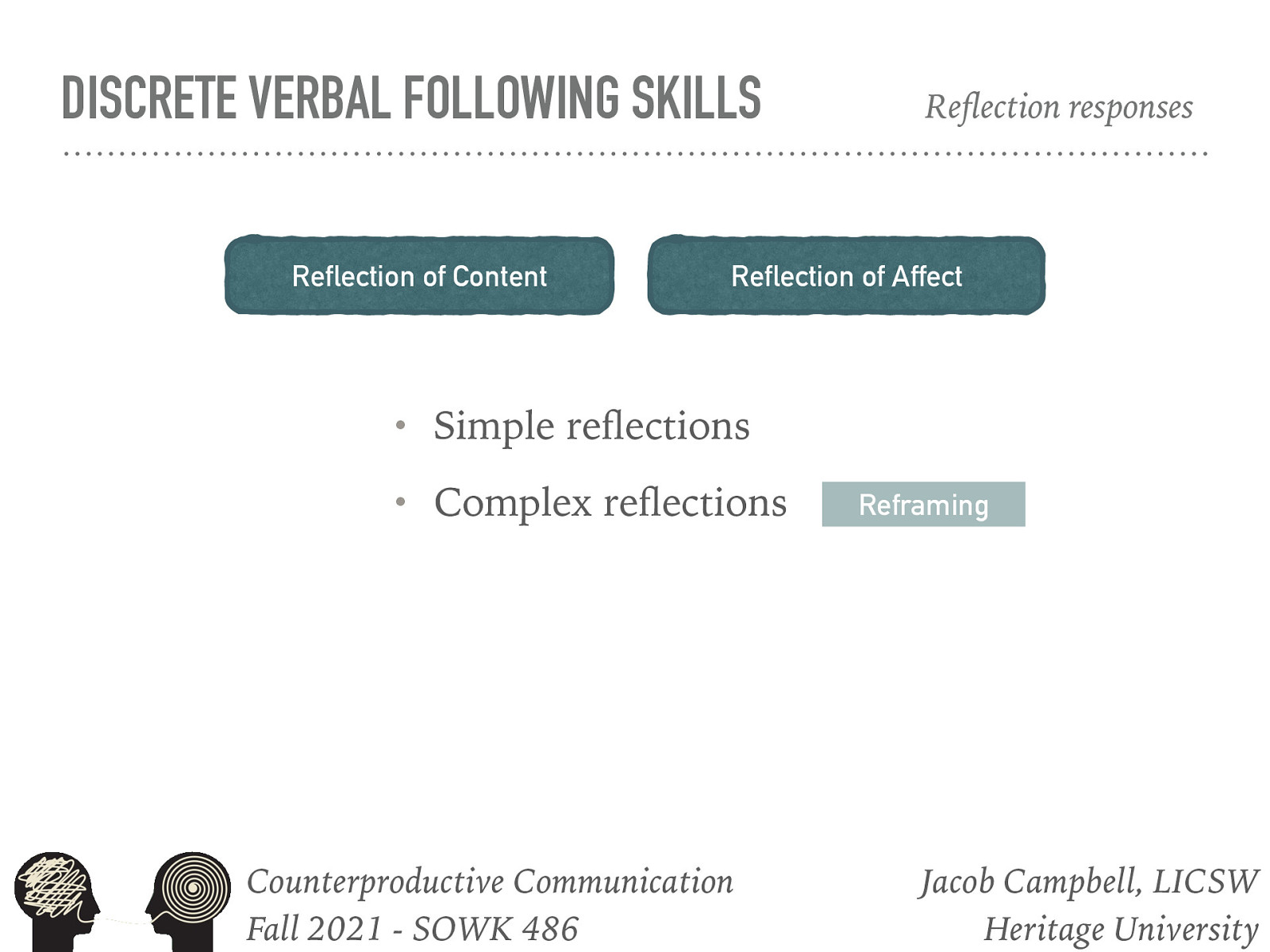
Reflection responses
One way of responding to a difficult story, such as the freedom writer clip we watch is through reflective responding. Lets talk about what each of these are:
There are two basic types of of reflection:
- Reflection of Content: emphasize the cognitive aspects of client messages, such as situations, ideas, objects, or persons (Hackney & Cormier, 2005).
- Reflection of Affect: focus attention on the affective part of the communication (Cormier, Nurius, & Osborn, 2009). In reflections of affect, social workers relate with responses that accurately capture clients’ affect and help them reflect on and sort through their feelings
Sometimes you see things such as paraphrasing, parroting, etc.
Reflection can take the form of the following forms:
- Simple reflections, which identify the emotions expressed by the client, are carried over from nondirective, client-centered counseling
Showing up at school that first day sounds like you were very anxious.
- Complex reflections go beyond what the client has directly stated or implied, adding substantial meaning or emphasis to convey a more complex picture
Showing up at school that first day it sounds like you were very anxious, but that you had a lot of determination to go regardless.
- Reframing: is another form of adding content. Here, the social worker puts the client’s response in a different light beyond what the client had considered (Moyers et al., 2003)
When you connected people in your support system, it sounds like it helped you feel more comfortable.
The text also talks about
- Double-sided reflection
- Reflections with a twist
and I don’t want to focus on those today.
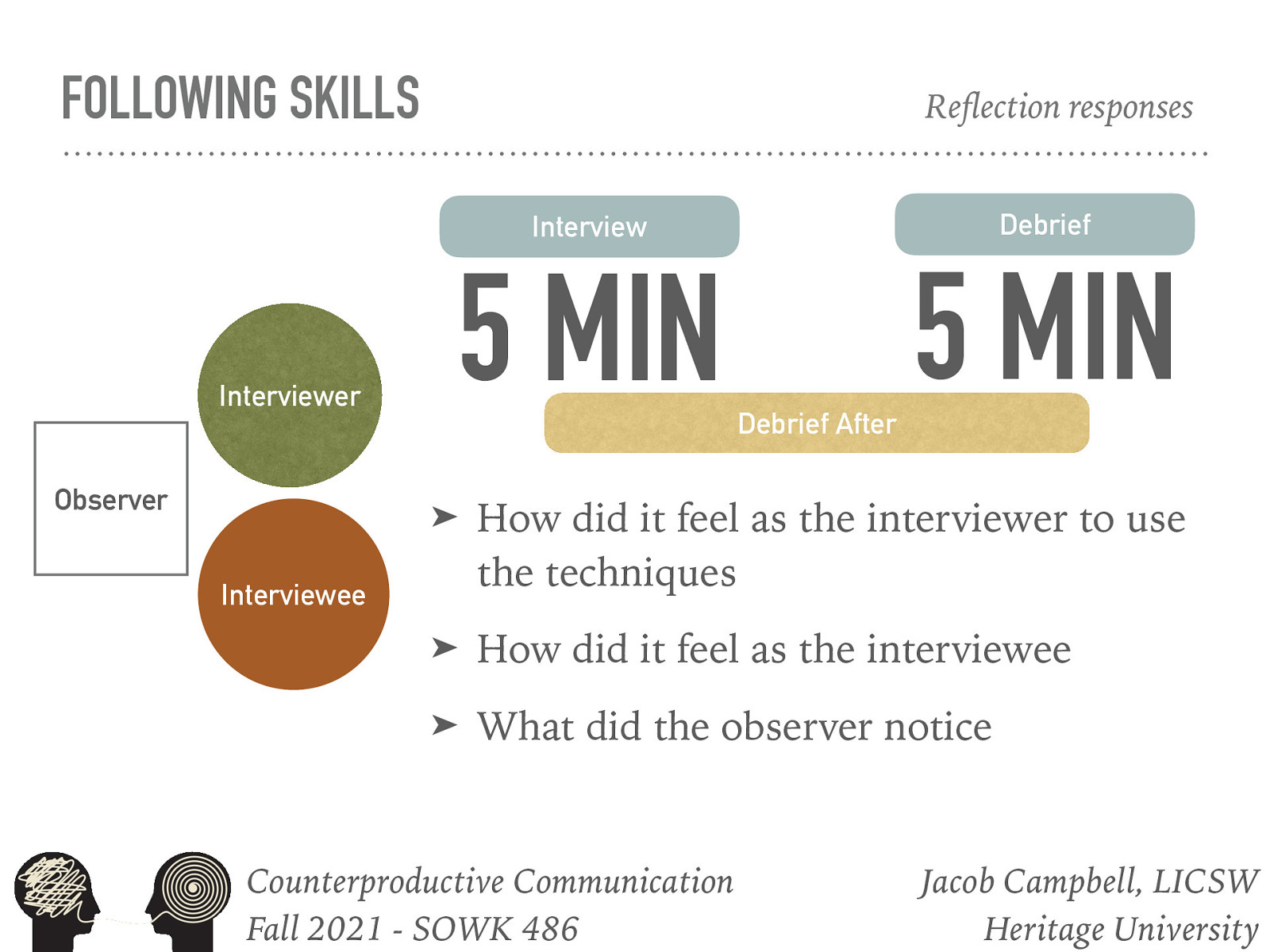
Following Skills: Reflective Responding
I want to spend some time today practicing reflecting responding. You can also be thinking about the other furthering responses in addition to this, but I want you to be thinking specifically about these.
[Small Group Activity] In groups of 3 (maybe four) you will have the opportunity to have a dialog. Talk about any topic that you would like. You will need to be able to talk about the topic for about 5 minutes minimum. It should be something that you are at least somewhat passionate about or has some sort of emotion tied to it. It could be a hobby, an interest, a story. Do the following:
- Assign roles to group members. Observer, interviewer, and interviewee.
- Pick the topic and have the interviewer guide the conversation, intentionally trying to use some reflective responding.
- After 5 minutes, debrief, using the following question (you will have about thee minutes)
- How did it feel as the interviewer to use the techniques
- How did it feel as the interviewee
- What did the observer notice
- Switch roles and do it again.
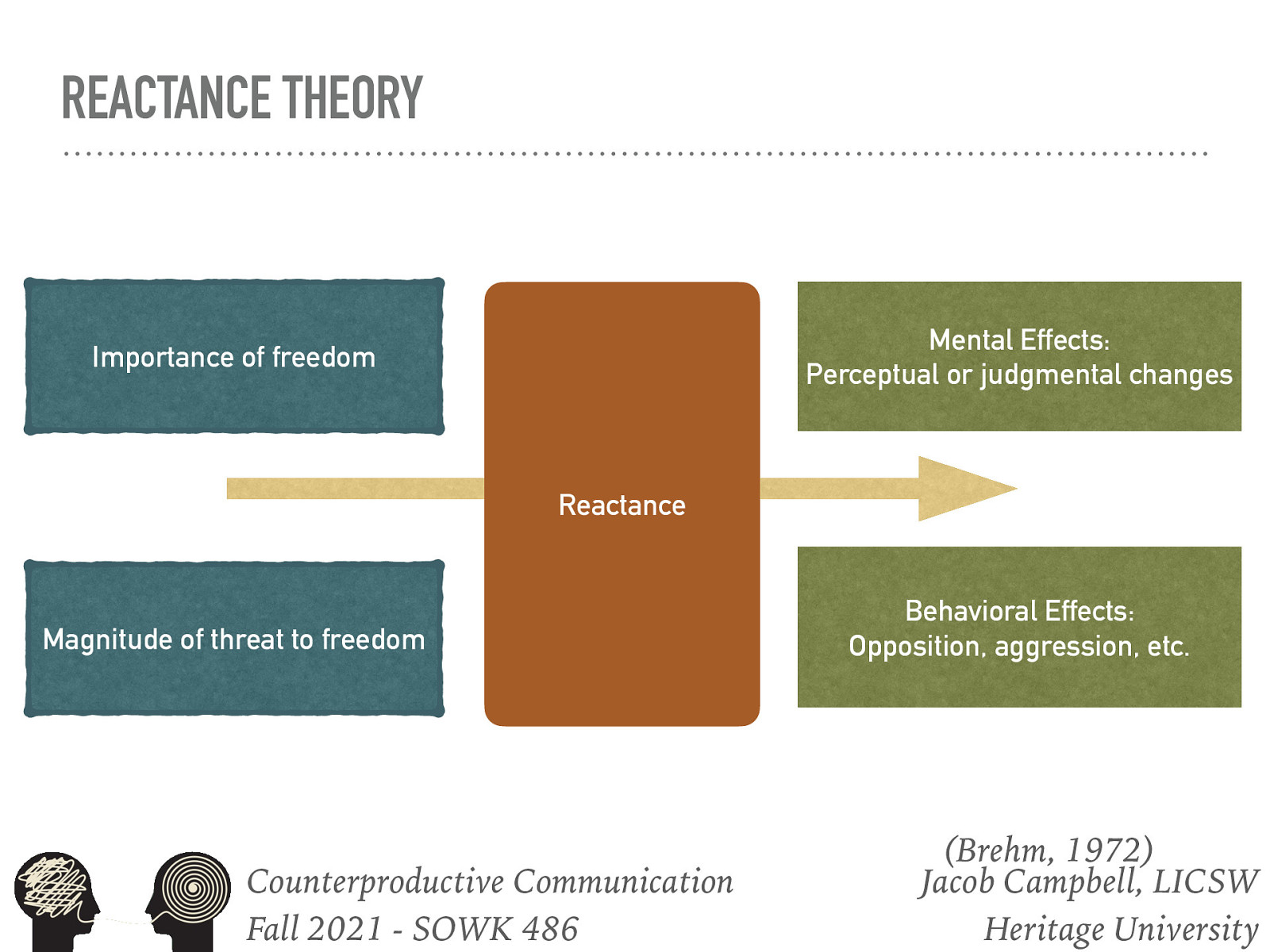
Reactance Theory
Brehm (1972) talked about Reactance (well and had been writing about it since the sixties).
- Importance of the freedom
- Magnitude of threat to freedom
Creates Reactance
- Mental Effects: Perceptual or judgmental changes
- Behavioral Effects: Opposition, aggression, etc.

Twelve Communication Roadblocks (1 of 4)
Communication is one area of constant and incremental improvement for everybody. I had an interesting experience when I was living in South America. I had gone down to Lima to get my camera fixed, and on my bus ride I ran into some problems.
Story about trip from Lima to Cusco
- From 21 hours to 36 hours
- Protest about governmental officials in province
- People blocking the road, throwing rocks, and painting vehicles
Generally our clients don’t throw rocks at us, but our communication, rapport, and ability to work with our clients will be improved when we reduce our roadblocks to effective communication.
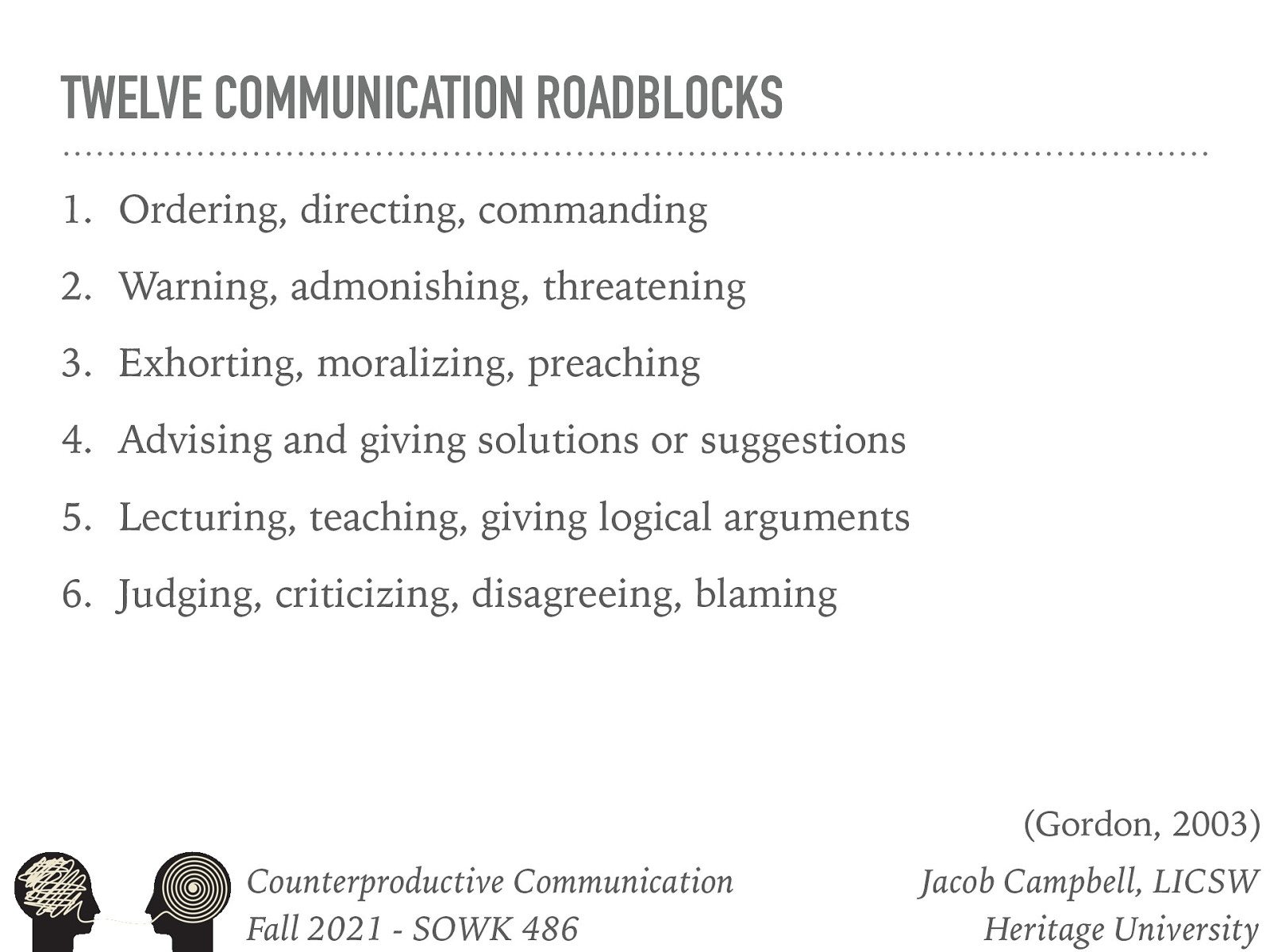
Twelve Communication Roadblocks (2 of 4)
Gordon, T (2003) Teacher effectiveness training. First Revised Edition. New York: Three Rivers Press
While Hepworth lays out 7 different road blocks, Gordon (2003) describes 12 different ones. They are all incorporated in parts of the the ones described by the book. I wanted to spend some time discussing these.
[Whole Class Activity] Discuss what each roadblock might look like in communication.
- Ordering, directing, commanding
- Warning, admonishing, threatening
- Exhorting, moralizing, preaching
- Advising and giving solutions or suggestions
- Lecturing, teaching, giving logical arguments
- Judging, criticizing, disagreeing, blaming
-> For information sake, the 7 roadblocks described by Hepworth
- Reassuring, sympathizing, consoling, or excusing
- Advising and giving suggestions or solutions prematurely
- Using sarcasm or employing humor that is distracting or makes light of clients’ problems
- Judging, criticizing, or placing blame
- Trying to convince the client about the right point of view through logical arguments, lecturing, instructing, or arguing
- Analyzing, diagnosing, or making glib or dogmatic interpretations
- Threatening, warning, or counterattacking
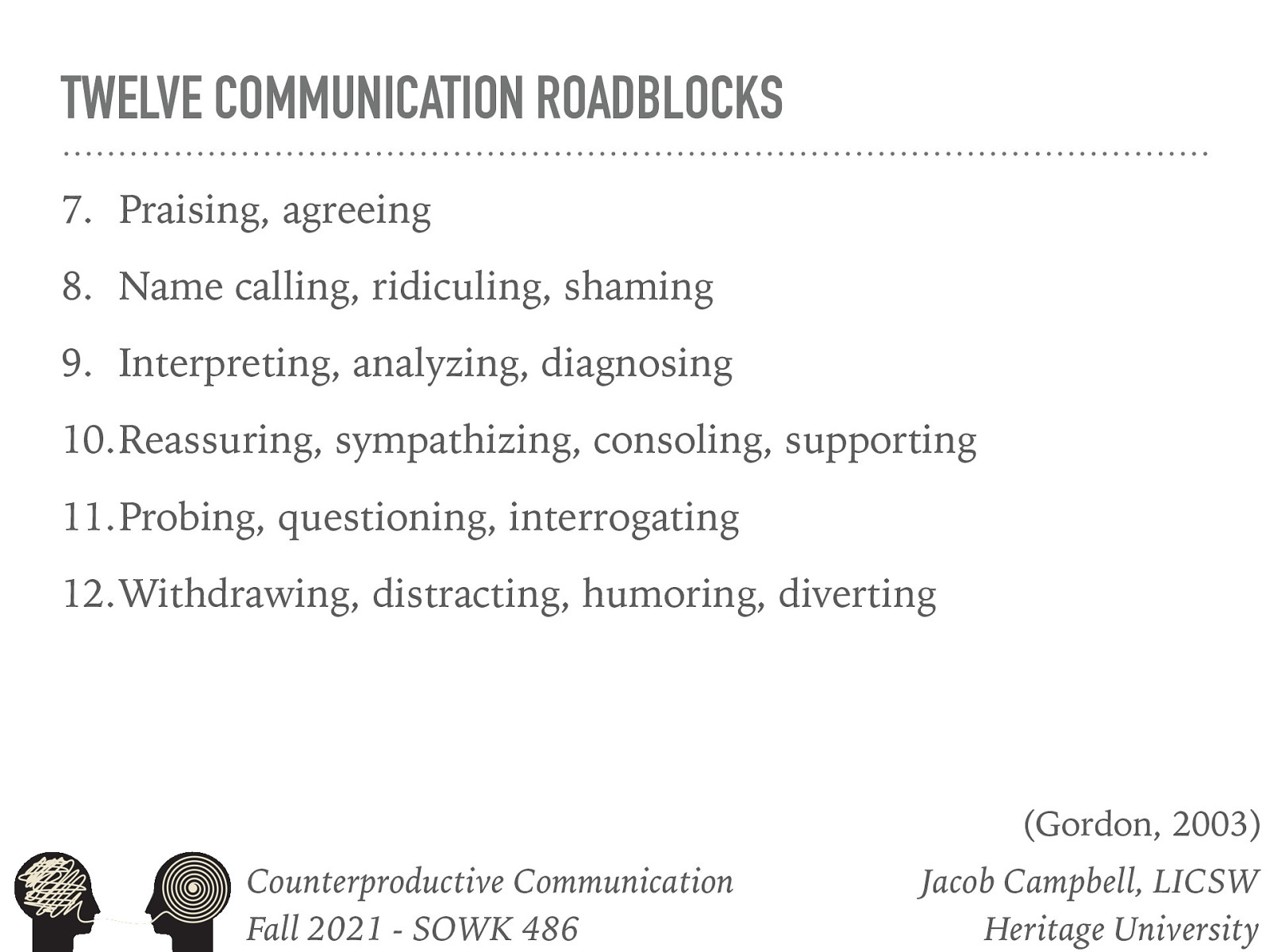
Twelve Communication Roadblocks (3 of 4)
- Praising, agreeing
- Name calling, ridiculing, shaming
- Interpreting, analyzing, diagnosing
- Reassuring, sympathizing, consoling, supporting
- Probing, questioning, interrogating
- Withdrawing, distracting, humoring, diverting
[Discussion] Do we ever do any of these?

Twelve Communication Roadblocks (4 of 4)
[Small Group Activity] Talk with a partner about how you sometimes fall into counter productive communication patters. You do not need to be overly personal, but it is helpful for everybody to recognize that we can improve our communication patterns. Please consider sharing any of the following, you do not have to go though all of the points:
- What counterproductive communication pattern you do
- How have you seen counterproductive communication impact a conversation
- A personal story about counterproductive communication in your life
- A way that you try to use positive communication patters in your life
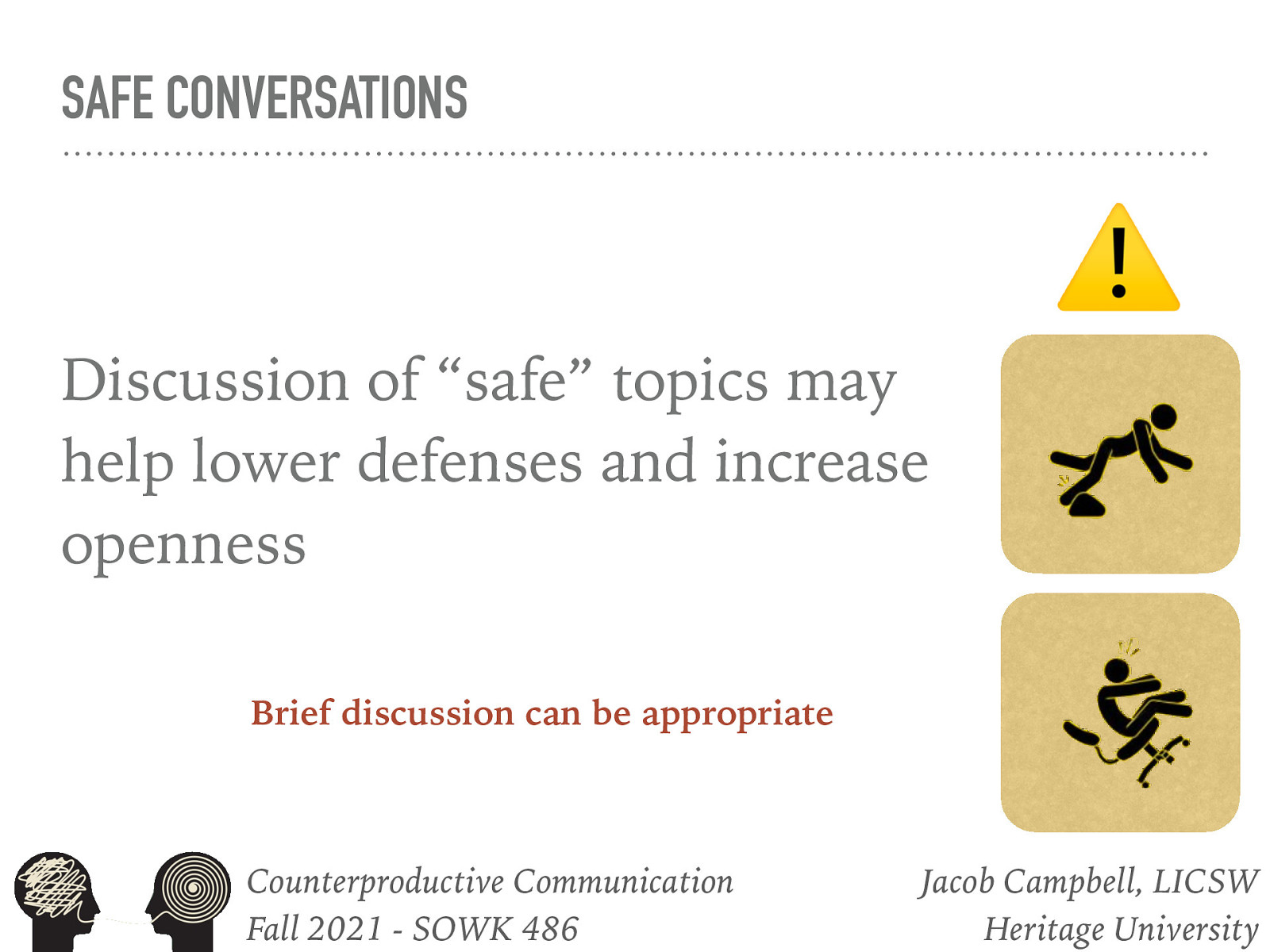
Safe Topics
It can be very easy to be in a comfort zone of “safe” topics. These can include social chit chat which tends to foster a social rather than therapeutic relationship.
- Discussion of “safe” topics may be utilized to help children or adolescents lower their defenses and risk increasing openness, thereby assisting social workers to cultivate a quasi-friend role with such clients.
Brief discussion of safe topics may be appropriate:
- Getting acquainted phase
- Warm-up period of sessions (can be culturally relevant)
Week seven and the topic of counterproductive communication builds on week six, which generally looks at just skills related to communication. Communication happens all of the time, and through both verbal and nonverbal patterns. As social workers, we have an obligation to look at how we are communicating and make an attempt to not be putting up barriers to have communication flow freely. The agenda for class this week is as follows:
- Nonverbal communication
- Verbal communication
- Review and practice with some furthering skills
- Barriers to communication
